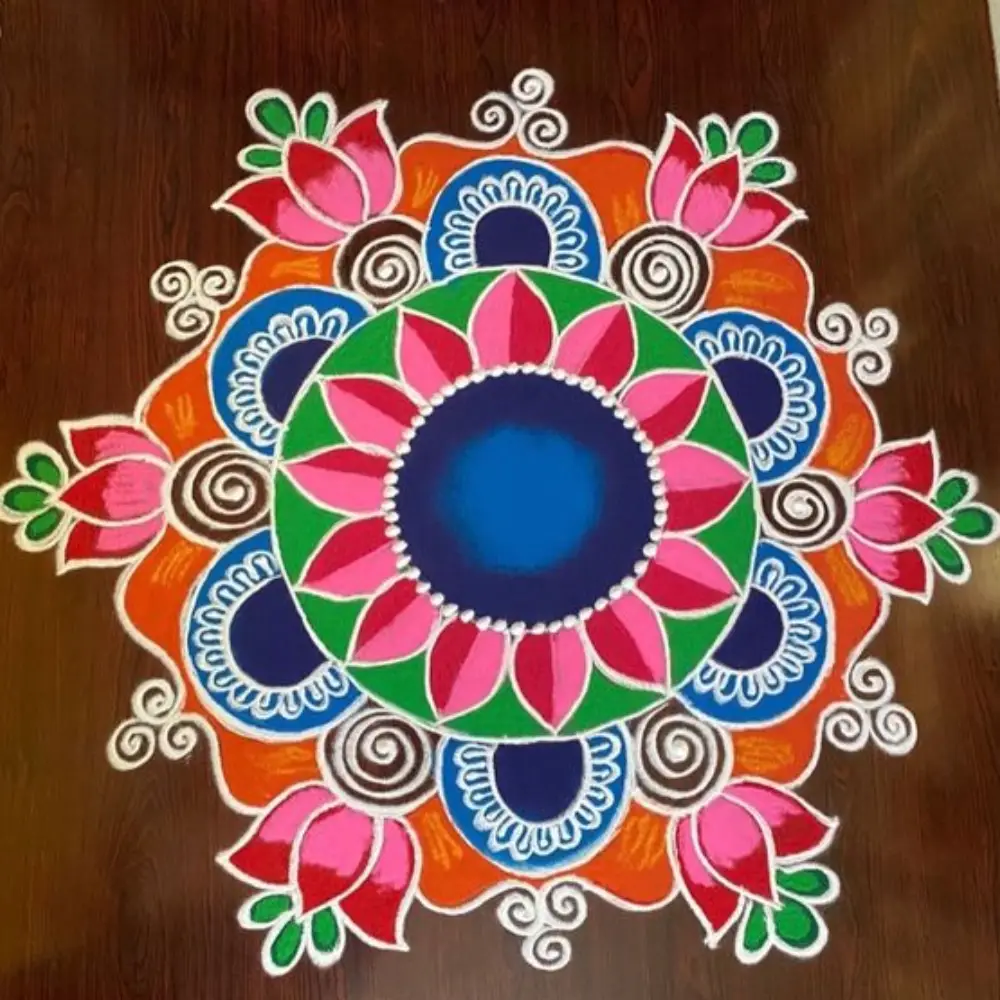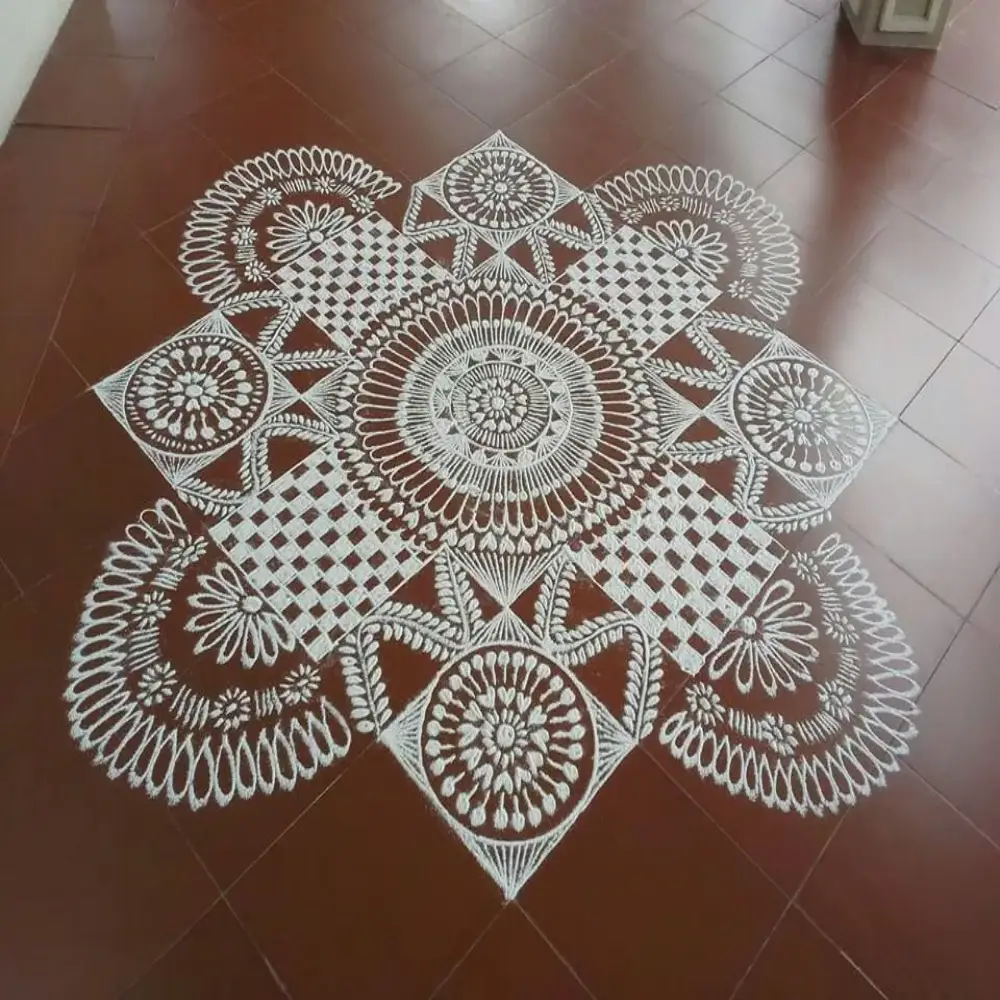Dussehra, also known as Vijayadashami, celebrates the victory of good over evil. It marks Lord Rama’s victory over Ravana and Goddess Durga’s win over Mahishasura. The festival bursts with vibrancy, creating beautiful Dussehra rangoli adds charm. Rangoli, an ancient Indian art form, brings colour, joy, and auspiciousness to homes and public spaces.
Making a Dussehra rangoli welcomes positivity and helps ward off negative energy. Let’s explore different Dussehra rangoli patterns you can create during this festival.

Understanding Dusshera Rangoli
Rangoli, a traditional Indian art form, adorns floors during festivals. Artists use coloured powders, rice, and flower petals to create intricate designs, enhancing the visual appeal and symbolising beauty and joy.


Types of Dussehra Rangoli
Kolam (Tamil Nadu): Kolam originated in Tamil Nadu and was traditionally created using chalk powder or rice flour. Nowadays, synthetic tinted powders are often used. Kolam is also native to Karnataka, Telangana, Kerela, Andhra Pradesh, and certain areas of Goa. Originally, people created kolams with grainy rice flour to feed ants, promoting peaceful coexistence by offering food to birds and other small animals.


Mandana (Rajasthan): This type of Rangoli design, unique to Rajasthan, gets its name from the famous Mandana paintings. People use Mandana to pray for good health, welcome gods, and celebrate festivals. Women create this beautiful artwork with chalk powder, using a bit of linen, a wisp of hair, and a primitive brush made from a date stalk.


Chowkpurana (Chhattisgarh): Chowkpurana is made using crisped rice flour and other types of white powdery residue, known for its kaleidoscopic patterns. While there are many classic Chaook designs, styles have evolved due to the creativity of the younger generation. Chaook is considered auspicious and symbolizes a family’s good fortune and wealth.


Alpana (West Bengal): Alpana originated from the Sanskrit word ‘alimpana,’ meaning ‘to plaster.’ Women used to create alpana before dusk at home. Fabric colors combined with a small amount of adhesive can create a more durable alpana. Use green from leaves and red from natural sources to achieve vibrant hues.


Jhoti (Odisha): In Odisha, this ancient art is known as Chita or Jhoti. Unlike other regions, Jhoti is typically drawn on walls. Housewives create the traditional designs using a semi-liquid paste made from rice flour, forming the white patterns. Small footprints of the goddess Lakshmi and various other designs are part of the Jhoti, symbolizing a deep connection between the supernatural and the mundane.

Popular Dussehra Rangoli Designs

Traditional Floral Dussehra Rangoli
Floral Rangoli designs are among the most popular choices for Dussehra. This style uses flower petals like marigolds, roses, and jasmine to bring simplicity and natural fragrance into your space. You can add symbols like swastikas or lotuses to represent spirituality and purity.
Tip: Combine bright yellow and red petals to signify energy and enthusiasm, aligning with Dussehra’s festive vibe.

Also Read: Diwali Decoration Ideas: Create a Magical Atmosphere at Home

Geometric Dussehra Rangoli Designs
Geometric Rangolis offer precision and symmetry. Circles, triangles, and squares come together to create intricate designs. These Rangolis blend traditional and modern elements, appealing to younger generations.
Tip: Use green, blue, and white outlines to make the design stand out, symbolizing harmony.


Goddess Durga Dussehra Rangoli
Dussehra often sees intricate Rangolis of Goddess Durga, honouring her victory over Mahishasura. These detailed designs require skilled hands and natural colours from turmeric, sandalwood, and organic materials. You can depict Durga carrying weapons, riding a lion, or standing victorious.
Tip: Deep reds and gold add a royal touch, symbolizing Durga’s power and grace.


Ravana-Themed Dussehra Rangoli
A creative choice for Dussehra involves depicting Ravana, the ten-headed king of Lanka. This design narrates the epic battle between Lord Rama and Ravana through art, often capturing Ravana’s many expressions.Tip: Use bold colours like black, orange, and purple to highlight Ravana’s distinct features.
Tip: Use bold colours like black, orange, and purple to highlight Ravana’s distinct features.


Peacock Dussehra Rangoli
Peacocks, sacred in Indian culture, often find a place in Dussehra Rangoli designs. The bird symbolizes beauty, grace, and royalty. Peacock Rangolis, designed using blues, greens, and purples, mesmerize with their vibrant display.
Tip: Add glitter to enhance the peacock’s feathers, bringing a festive sparkle to the design.


Floating Dussehra Rangoli
Floating Rangoli has gained popularity, adding a unique dimension to traditional designs. This type involves using water, flower petals, and floating candles to create a serene yet festive atmosphere.
Tip: Use lotus flowers and diyas to enhance the spiritual feel of this design.


Mirror and Glass Dussehra Rangoli
Mirror and glass Rangolis stand out for their unique reflective qualities. Small mirrors or glass pieces, combined with coloured powders, create stunning designs. The reflection is mesmerising, especially when lit with lamps and candles.
Tip: Pair these designs with yellow and white lights to illuminate your space and showcase your creativity.

Also Read: Chandigarh Famous Food: A Culinary Guide to Must-Try Delicacies

Materials Used for Dussehra Rangoli
- Traditional Materials: Colored powders made from natural ingredients and fresh flower petals remain the go-to choice for traditional Rangoli, symbolizing purity and spirituality.
- Modern Materials: Glitter, beads, and stencils allow modern Rangoli artists to create elaborate, textured designs.

Step-by-Step Guide to Creating Dussehra Rangoli
- Plan Your Design: Choose a design that reflects Dussehra’s spirit. Sketch it on paper and decide on the colours and materials.
- Gather Materials: Collect all necessary items, such as coloured powders, flowers, glitter, and stencils. Preparing beforehand helps ensure a smooth process.
- Create the Base Design: Outline the base of your design with white chalk or powder, serving as a guide for adding colours.
Add Details and Colors: Fill in the details with the chosen colours. Take your time to keep the design neat and vibrant.

Tips to Make Your Rangoli Stand Out
- Choose the Right Colors: Bright, contrasting colours make a Rangoli pop and reflect the festive mood.
- Maintain Symmetry: Use a ruler or stencil to ensure even spacing and a professional finish.
- Incorporate Symbols and Motifs: Add symbols like Lord Rama or Ravana to enhance your design’s thematic relevance.

Frequently Asked Questions (FAQs)

Conclusion:
Making Rangoli for Dussehra provides a fun, creative way to celebrate the festival. Whether you choose traditional, modern, or eco-friendly designs, your Rangoli will add beauty and joy to the occasion. So gather your materials, let your creativity flow, and enjoy crafting a stunning Rangoli!
Please let us know in the comments section below or email us via the contact page at “The Simple Indian “, which Dussehra rangoli you like the most and going to try for the coming Dussehra festival! Remember, we’re always here to answer your questions and hear your suggestions. Become a part of “The Simple Indian” family today.
Table of Contents
- Understanding Dusshera Rangoli
- Types of Dussehra Rangoli
- Kolam
- Mandana
- Chowkpurana
- Alpana
- Jhoti
- Popular Dussehra Rangoli Designs
- Materials Used for Dussehra Rangoli
- Step-by-Step Guide
- Tips to Make Your Rangoli
- FAQs
- Conclusion
- Leave a Comment





